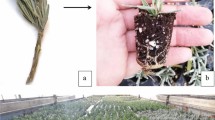Abstract
To evaluate the 13 carrot cultivars against Meloidogyne incognita under green house conditions; different levels of susceptibility were observed in all the examined cultivars. Cultivar Golden Rosy was resistant to nematode attack with a low root gall index (1.2) while cultivar Kamini was found highly susceptible showing the highest root gall index (5.0). Similarly, the cultivars Rose Red, Noorie, Lali, Sindhuri, and Selection 80 were susceptible; the cultivars Pearl Red, Super Red, Surbhi, and Kamboj were moderately susceptible and the cultivars Desi Red and Red King were found moderately resistant against the nematode damage. A negative and significant correlation was found between root-knot nematode infestation and plant growth parameters.



Similar content being viewed by others
References
Anita B, Selvaraj N (2011) Biology, yield loss and integrated management of root-knot nematode, Meloidogyne hapla infecting carrot in Nilgiris. Indian J Nematol 41:144–149
Ansari T, Asif M, Siddiqui MA (2018) Resistance screening of lentil cultivars against the root-knot nematode Meloidogyne incognita. Hell Plant Prot J 11:9–18. https://doi.org/10.2478/hppj-2018-0002
Asif M, Khan A, Tariq M, Siddiqui MA (2016) Sustainable management of root-knot nematode Meloidogyne incognita through organic amendment on Solanum lycopersicum L. Asian J Biol 1:1–8. https://doi.org/10.9734/AJOB/2016/30739
Asif M, Ahmad F, Tariq M, Khan A, Ansari T, Khan F, Siddiqui MA (2017) Potential of chitosan alone and in combination with agricultural wastes against the root-knot nematode, Meloidogyne incognita infesting eggplant. J Plant Prot Res 57:288–295. https://doi.org/10.1515/jppr-2017-0041
Atkinson HJ, Lilley CJ, Urwin PE (2012) Strategies for transgenic nematode control in developed and developing world crops. Curr Opin Biotechnol 23:251–256. https://doi.org/10.1016/j.copbio.2011.09.004
Caveness FE, Ogunforowa AO (1985) Nematological studies worldwide. In: Singh SR, Rachie KO (eds) Cowpea research production and utilization. Wiley and Sons, Chichester, pp 273–285
Cobb NA (1920) Estimating the nematode population of the soil. Agric Tech Circ Bur Pl Ind US Dep Agric 1:19–24
Cousins P, Walker MA (2000) Improved techniques for evaluating root knot nematode resistance in Vitis root stocks. Acta Hortic 528:577. https://doi.org/10.17660/ActaHortic.2000.528.84
Di Vito M, Volvos N, Castillo P (2004) Host parasite relationship of Meloidogyne incognita on spinach. Plant Pathol 253:508–514. https://doi.org/10.1111/j.1365-3059.2004.01053.x
Eisenback JD (1985) Detailed morphology and anatomy of second-stage juveniles, males, and females of the genus Meloidogyne (root-knot nematodes). In: Sasser JN, Carter C (eds) An advanced treatise on Meloidogyne. Biology and control, vol 1. North Carolina State University Graphics, Raleigh, pp 47–77
Hussain MA, Mukhtar T, Kayani MZ (2011) Efficacy evaluation of Azadirachta indica, Calotropis procera, Datura stramonium and Tagetes erecta against root-knot nematodes Meloidogyne incognita. Pak J Bot 43:197–204
Irshad U, Mukhtar T, Ashfaq M, Kayani MZ, Kayani SB, Hanif M, Aslam S (2012) Pathogenicity of citrus nematode (Tylenchulus semipenetrans) on Citrus jambhiri. J Anim Plant Sci 22:1014–1018
Kayani MZ, Mukhtar T, Hussain MA (2012) Evaluation of nematicidal effects of Cannabis sativa L. and Zanthoxylum alatum Roxb. against root-knot nematodes, Meloidogyne incognita. Crop Prot 39:52–56. https://doi.org/10.1016/j.cropro.2012.04.005
Kinlock RA, Hinson K (1972) The Florida program for evaluating soybean (Glycine max (L.) Merr.) genotypes for susceptibility to root-knot nematode disease. Proc Soil Crop Sci Soc Fla 32:173–176
Mukhtar T, Kayani MZ, Hussain MA (2013) Response of selected cucumber cultivars to Meloidogyne incognita. Crop Prot 44:13–17. https://doi.org/10.1016/j.cropro.2012.10.015
Mukhtar T, Hussain MA, Kayani MZ, Aslam MN (2014) Evaluation of resistance to root-knot nematode (Meloidogyne incognita) in okra cultivars. Crop Prot 56:25–30
Nelson SC, Starr JL, Simpson CE (1990) Expression of resistance to Meloidogyne arenaria in Arachis batizocoi and Arachis cardenasii. J Nematol 22:423–425
Southey JF (1986) Laboratory methods for work with plant and soil nematodes. HMSO, London, p 202
Taba S, Sawada J, Moromizato Z (2008) Nematicidal activity of Okinawa island plants on the root-knot nematode Meloidogyne incognita (Kofoid and White) Chitwood. Plant Soil 303:207–216. https://doi.org/10.1007/s11104-007-9499-7
Taylor AL, Sasser JN (1978) Biology, identification and control of root-knot nematodes Meoidoglyne spp. Department of Plant Pathology, Raleigh, p 111
Vagelas I, Gowen SR (2012) Control of Fusarium oxysporum and root-knot nematodes (Meloidogyne spp.) with pseudomonas oryzi habitans. Pak J Phytopathol 24:32–38
Vovlas N, Mifsud D, Landa BB, Castillo P (2005) Pathogenicity of the root-knot nematode Meloidogyne javanica on potato. Plant Pathol 54:657–664. https://doi.org/10.1111/j.1365-3059.2005.01244.x
Widmer TL, Ludwig JW, Abawi GS (1999) The northern root-knot nematode on carrot, lettuce, and onion in New York, Cornell University, Geneva. http://hdl.handle.net/1813/1508
Acknowledgements
The authors are highly thankful to the University Grant Commission, New Delhi, for funding this research and the chairman, Department of Botany, AMU, Aligarh, for providing necessary facilities during the course of work.
Author information
Authors and Affiliations
Corresponding author
Rights and permissions
About this article
Cite this article
Khan, F., Asif, M., Khan, A. et al. Screening of carrot cultivars against root-knot nematode Meloidogyne incognita. Indian Phytopathology 71, 415–421 (2018). https://doi.org/10.1007/s42360-018-0052-9
Received:
Revised:
Accepted:
Published:
Issue Date:
DOI: https://doi.org/10.1007/s42360-018-0052-9




